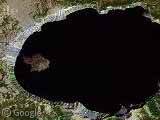The Skeletons of Roopkund Lake
Thursday, 16th September 2010 by Alex Steinberger
Roopkund Lake lies tucked amongst the towering peaks of the Indian Himalayas at an elevation of more than 5,000 metres. Frozen almost year-round and extremely remote, this frigid alpine lake can only be reached on foot, four days walk from the nearest settlement. Despite its isolation, Roopkund has its own macabre history. Hidden beneath its icy depths is a mass grave of sorts, the eternal resting place of hundreds of human skeletons.
The discovery was made in 1942 by a park ranger who stumbled across the 300-600 skeletal and mummified bodies strewn about the slopes and at the bottom of this precariously perched lake. Early speculation as to how the remains came to exist in this deserted part of the Himalayas included an epidemic, ritual sacrifice, or landslides. When viewed in Google Earth, it becomes apparent how truly rugged Roopkund is:
Initial archeological research into the Roopkund Lake site revealed that the dead were made up of a two groups of outwardly different but genetically similar individuals. One, mostly short and presumably made up of porters or servants, and another much taller group that was most likely royalty. Carbon dating undertaken in the 1960s also suggested that the deceased individuals at Roopkund lake perished quite suddenly sometime between 500 to 700 years ago.
The cause behind the mass grave at Roopkund remained a mystery until 2004 when additional research, spurred by a National Geographic Society documentary, unearthed new facts about the skeleton lake. It was found that the remains were not only much older than originally thought, dating from 850 A.D. to be more exact, but also that the all the deceased individuals had been victims of a massive and obviously deadly hail storm.
Further study of the fractured skulls revealed that the unlucky lot at Roopkund lake would have had little or no shelter from this epic storm. Most would have succumbed quickly to the volley of hailstones which archeologists believe were the size of cricket balls!
What is still unclear is why such a large group came to be in this desolate corner of the Himalayas. Roopkund Lake is not on or even remotely near any trade routes and is not historically known for being a site of religious pilgrimage. Today the lake is visited only by groups of hardy trekking tourists looking for a taste of breathtaking Himalayan beauty. One can only hope that they bring along a sturdy helmet in case of bad weather!
Thanks to Atlas Obscura and National Geographic.







I enjoyed the article very much, as I do with all your email broadcasts. What got my attention this time is that the author did not expand on the dimensions of a cricket ball. Us Yanks know golf-balls, baseballs, footballs and soccer balls. But what is the dimension of a cricket ball?
Hey Dave S!
I have to admit, I’m a yank as well so I should have thought to put in dimensions for the uninformed. Here they are: A cricket ball weighs between 5.5 and 5.75 ounces measures about 9 inches in circumference. By way of comparison, it’s about the size of a baseball but just a little bit heavier. Now imagine that, made of ice, raining down on you at 50 mph…sounds pretty unpleasant.
this is a cool site to be on.
Thank you Alex for this, really good.
You Froze my heart! This is absolutely fabulous place in the world!